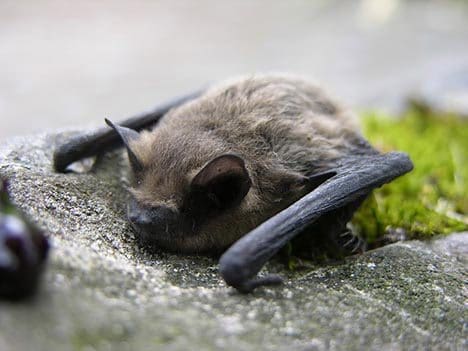Bat Kills at Wind Turbines
Recent studies have reported large numbers of bats being killed at wind farms in many parts of North America and Europe. Project monitoring has also
discovered significant bat mortality at the Mexico La Venta II wind
farm. Bat kills at wind turbines were first discovered in Australia.
Small numbers of bats were first recorded in the United States at wind power projects in California during bird monitoring.
Some time ago, an estimated 1,400-4,000 bats
were recorded as killed during 2008 at the Mountaineer Wind Energy
Center in West Virginia . High bat mortality at that site has continued
since then.
The frequency and number of bat kills at wind turbines are much greater than for any other type of human-built structure.
Unlike birds, bats strike wind towers as well as telecommunications towers, buildings or power lines, but very infrequently.
Bat Mortality from Collisions and Barotrauma
 |
| The bat killed by wind turbine blades |
Bats that fly too close to wind turbines are killed by either direct impact or from major air pressure changes around the spinning rotors.
While bats clearly are killed by direct collision with turbine blades, up to 50 percent of the dead bats around wind turbines are found with no visible sign of injury.
The
cause for this non-collision mortality is believed to be a type of
decompression known as barotrauma, resulting from rapid air pressure
reduction near moving turbine blades.
Barotrauma kills bats near
wind turbines by causing severe tissue damage to their lungs, which are
large and pliable, thereby overly expanding when exposed to a sudden
drop in pressure.
By contrast, barotrauma does not affect birds because they have compact, rigid lungs that do not excessively expand.
Bat Atraction to Wind Turbines
Many species of bats appear to be significantly attracted to wind turbines for reasons that are still poorly understood.
Here we’re gonna try to summarizes the more plausible scientific hypotheses that have been advanced to date. By contrast, birds are not normally attracted to wind turbines, and simply collide with them by accident.
 |
The
Eastern Red Bat Lasiurus borealisis typical of the migratory,
tree-roosting bat species that are frequent casualties at some wind
farms in North America.
|
Hypotheses for Bat Attraction to Wind Turbines
Various scientific hypotheses have been proposed as to why bats are seemingly attracted to and/or fail to detect wind turbines
The more plausible hypotheses include the following:
1. Auditory Attraction
Bats may be attracted to the audible “swishing” sound
produced by wind turbines. Museum collectors seeking bat specimens have
used long poles that were swung back and forth to attract bats and then
knock them to the ground for collection.
It is not known if these bats were attracted to the audible “swishing” sound, the movement of the pole, or both factors.
2. Electromagnetic Field Disorientation
Wind turbines produce complex electromagnetic fields, which may cause bats in the general vicinity to become disoriented and continue flying close to the turbines.
3. Insect Attraction
As flying insects
may be attracted to wind turbines, perhaps due to their prominence in
the landscape, white color, lighting sources, or heat emitted from the
nacelles, bats would be attracted to concentrations of prey.
4. Heat Attraction
Bats may be attracted to the heat produced by the nacelles of wind turbines because they are seeking warm roosting sites.
5. Roost Attraction
Wind turbines may attract bats because they are perceived as potential roosting sites.
6. Lek Mating
Migratory
tree bats may be attracted to wind turbines because they are
the highest structures in the landscape along migratory routes, possibly
thereby serving as ren-dezvous points for mating.
7. Linear Corridor
Wind farms constructed along forested ridge-tops create clearings with linear landscapes that may be attractive to bats.
8. Forest Edge Effect
The
clearings around wind turbines and access roads located within forested
areas create forest edges. At forest edges, insect activity might well
be higher, along with the ability of bats to capture the insects in
flight.
Resident bats as well as
migrants making stopovers may be similarly attracted to these areas to
feed, thus increasing their expo-sure to turbines and thus mortality
from collision or barotrauma.
9. Thermal Inversion
Thermal inversions create dense fog in cool valleys, thus concentrating both bats and their insect prey on ridge-tops.
Bat Species Most Significantly Affected
 |
| The bat killed by wind turbine blades |
In North America, migratory bat species have been found dead at wind farms much more frequently than the resident (non-migratory) species, even in areas where the resident species are more common throughout the summer.
Eleven
of the 45 species of bats that occur in North America north of Mexico
have been found dead at wind farms, but most studies report that the
mortality is heavily skewed towards migratory, tree-roosting species
such as Hoary Bat Lasiurus cinereus, Eastern Red Bat Lasiurus borea-lis,
and Silver-haired Bat Lasionycteris noctivagans.
While these
three species are not listed as threatened or endangered under the U.S.
Endangered Species Act, they are classified as of Special Management Concern
at the provincial level in Canada. Although the globally
endangered Indiana Bat Myotis sodalishas not yet been found dead at wind
farms, potential new wind farms within this species’ remaining
strongholds could possibly threaten it.
In Europe, 19 of the 38 species of bats found within the European Union have been reported killed by wind turbines.
Although migratory species are among the most numerous casualties, resident bats are also killed in substantial numbers, particularly in forested areas.
Turbine-related
bat mortality has been found in every European country in which bat
monitoring has been done, except for Poland where no dead bats were
found during monitoring at two sites. The highest numbers of bat
fatalities have been found in Germany and France, which is almost
certainly due to the more extensive monitoring carried out in those
countries.
No comments:
Post a Comment